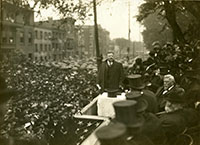Dedication of the Pennsylvania Capitol - October 4, 1906
Images
Click images for larger versions.
History
Manuscript Group 152: S. Emerson Bolton Collection: "The President Delivering His Address", October 4, l906 at Harrisburg. 8" X 10" silver gelatin print. Photograph by William H. Rau Studios.
Pennsylvania's new capitol, located on Third Street between North and Walnut Streets in Harrisburg, was dedicated on October 4, 1906. Its predecessor had been destroyed by fire on February 2, 1897. In the interval, the Grace Methodist Church on State Street served as a temporary capitol.
In Pennsylvania's early years, the capital moved frequently. William Penn intended to make Upland, now known as Chester, located along the Delaware River, the colony's capital. The first session of the legislature met there in 1682. Later he decided on Philadelphia, where for several decades Assembly and Council gathered in private homes, Friends' Meeting Houses, and the Philadelphia County Courthouse. In 1729, the assembly resolved to construct its own building, where it met for the first time in 1735. This stately Georgian style building still stands on Chestnut Street and is today known as "Independence Hall" because the Second Continental Congress met there when it approved the Declaration of Independence in early July, 1776. As Pennsylvanians moved into the interior, legislators wanted the capital closer to the center of the state's population. Consequently in 1799 they moved it to Lancaster, and in 1810 decided on Harrisburg as a "permanent" capital. The new structure was built on a tract of land originally owned by John Harris, the town's founder; Congressman William McClay; and several other residents. It was dedicated on January 22, 1822. This building sufficed for seventy-five years.
A few months after this capitol burned, the legislature authorized construction of a new one to be built of fireproof material-brick, stone, and iron. As the structure took shape, legislators expressed their disapproval of its appearance charging that Pennsylvania farmers' barns were more attractive. As a result, they changed architects and commissioned the young and comparatively unknown Joseph M. Huston to design the new capitol. Huston was inspired by the buildings that he visited in Europe, especially the magnificent St. Peter's Cathedral in Rome, the dome of which he duplicated in Pennsylvania's capitol. The building rises 272 feet from the ground to the statue of "Commonwealth" and 254 feet deep, and covers approximately two acres of space. Occupying an elevation called "Capitol Hill," it can be seen from almost all sides.
The dedicatory ceremonies were impressive. President Theodore Roosevelt was present, as was Governor Samuel W. Pennypacker, who introduced the President, saying "of all the rulers of the earth, the greatest is the President of the United States." "A vast multitude" attended the event that was held along Third Street in front of the capitol. "No more notable event had occurred within the confines of the state for many a year."
A photographer for William H. Rau Studios, who appears to the right of the center in the picture, captured the spirit of the event. Rau was one of the most highly respected men in his profession and had photographed many important events and people. President Theodore Roosevelt, who called the new capitol the "handsomest building I ever saw" stands in the center clutching what probably is his speech in his right hand. He had discarded his top hat despite the rain that caused many in the crowd to raise their umbrellas. Looking at the image, one can almost hear him proclaim in his high pitched voice that "in every crisis of our government the attitude of Pennsylvania has been of crucial importance, as the affectionate name of Keystone State signifies." Governor Samuel W. Pennypacker is to the right of the President, arrayed in gubernatorial dignity-- black suit, bow tie, cape, white hair, mustache, beard, and glasses. Other dignitaries on the platform that day included: ex-Governor William A.Stone (1899-1903), who served as president of the Capitol Building Commission; Pennsylvania's United States Senators Boise Penrose and Philander C. Knox; former Senator J. Donald Cameron, whose father was a prominent Pennsylvania political leader; Mayor Edward Gross of Harrisburg; Mayor John Weaver of Philadelphia; and Vance C. McCormick, former Mayor of Harrisburg and prominent area businessman.
Critics charged that corruption characterized the construction of the Commonwealth's new capitol. Indeed one labeled it "Pennsylvania's Colossal Temple of Fraud." Costs exceeded more than three-fold the limit of $4,000,000.00 that the legislature had set in 1901. State Treasurer William H. Berry obtained independent estimates of the cost of the capitol's decorations and furnishings. They revealed that the state had paid $5,500 for the ceiling in Berry's office that should have cost $550; the "Oak wainscoting worth $1,800" actually cost the state $15,500; a contractor who "had offered to supply a chandelier for $193" had charged the state $2,000; and a state official paid $150 for a boot black stand but collected $1,619 for it from the State. Berry estimated that the state had paid $5,000,000 more for its capitol than it should have."
Pennsylvania emerged from the problems that had developed before, during, and after construction with a beautiful and useable capitol. Statues by the noted sculptor George Grey Barnard were added to the grounds in 1911. Later the landscaping was changed to accommodate automobiles. Since 1983 the Capitol Preservation Committee has successfully completed more than fifty projects to ensure the preservation of the capitol. It continues to be "one of the most beautiful symbols of the state's heritage" and in several ways is a monument to Pennsylvania's political and civic traditions.
